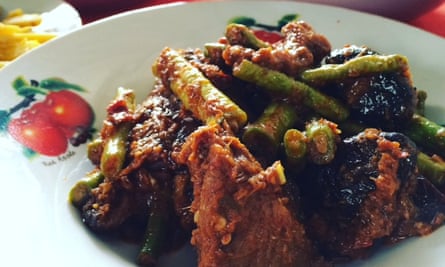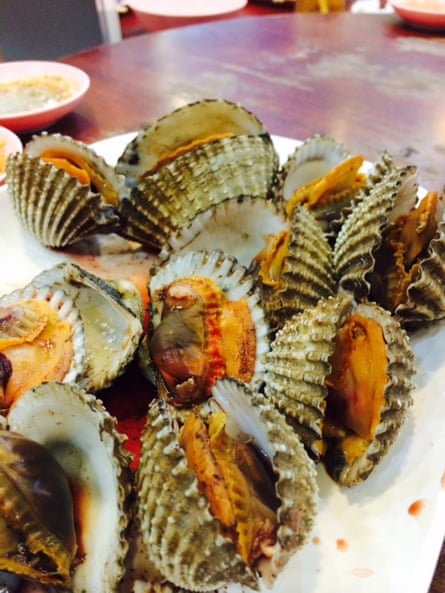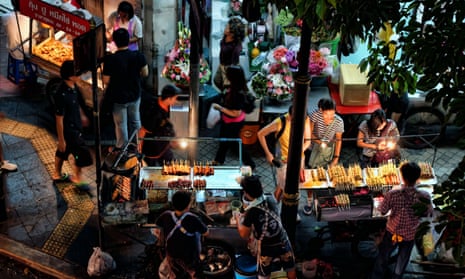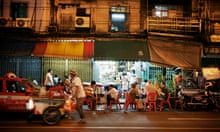The world of Thai street food can be an exciting, if occasionally bewildering, place. Bangkok can provide intrepid diners with hours of culinary exploration, but that’s provided they know where to go. Here is a guide to the best neighbourhoods for food-on-the-go in the Thai capital.
Chinatown
No exploration of Bangkok’s street food is complete without a trip to Chinatown (referred to among locals as Yaowarat), which is considered the birthplace of street food in Thailand and remains a prime foodie destination. And any discussion of Thai street food must also include a mention of satay – meat that is threaded on a bamboo stick, grilled over an open flame and served with peanut sauce and an ajad of cucumber, shallots and chillies in sugar syrup. Although it sounds simple enough, satay is hard to make memorable. This is where Jay Eng (105 Charoen Krung Road, on the pavement opposite the Chao Por Heng Jia shrine) comes in: tender, coconut milk-kissed meat with a hint of char, alongside a sauce full of nutty flavour.

The origins of the popular sweet snack lod chong Singapore are murky. Some say the green-coloured squiggles, made of sticky rice flour, are modelled after the Chinese-inspired dish popular in Singapore – hence the name. Others say the treats, which come floating in a glass of sweet, iced coconut milk with a scattering of cubed jackfruit, was first sold in front of a shopfront bearing the word “Singapore”. Whatever its origins, Lod Chong Singapore (Charoen Krung Road, across from Sirirama Hospital), named after its only dish, was one of the first vendors to sell it in Bangkok.
Thai-style sukiyaki – a wok-fried melange of glass noodles, egg and seafood with a chilli sauce liberally laced with pickled garlic – has never been a photogenic dish. Yet it remains one of Thailand’s most popular street foods. Elvis Suki (200/37 Soi Yodsae) is among the most enduring purveyors of this dish, and also offers a great grilled scallop with garlic butter and grilled seabass stuffed with lemongrass, kaffir lime leaves and coriander.
Old Town
Bangkok’s Old Town – also known as Banglamphu, after the lamphu trees that once lined the area’s many canals – is a treasure trove of old-style Thai street food specialities that are hard to find elsewhere. Here, the most famous vendors have been around for decades, nourished by several generations’ of culinary know-how.

Khao gang (curry rice) is a fixture on Bangkok’sstreets. A popular breakfast and lunch option for diners on the go, curry rice is a selection of curries and stir-fries, any combination of which can be piled on to a plate of rice. The best of these vendors, such as Khao Gaeng Rattana (Nang Loeng Market) inspire an almost cult-like following of people happy to sample whatever the vendor has decided to cook that day. In Rattana’s case, those popular dishes include gang kiew waan gai (green chicken curry) and gang som goong (sour curry with shrimp).
Considered one of Bangkok’s best street food cooks, Jay Fai (327 Mahachai Road) is also one of the city’s most expensive: her tom yum talay (spicy lemongrass soup with seafood) can cost as much as 1,500 baht (£28). Although many local gourmets bemoan her sky-high prices, few contest her skill with the wok. This self-taught cook specialises in stir-fried noodle dishes, but perhaps her most popular is guay tiew pad kee mow (also known as “drunken noodles”, or noodles fried with lots of chillies, said to be popular with partygoers out on the town).

Handmade ice-cream is not a typical street food dish in Bangkok, but Nuttaporn Ice Cream (94 Phraeng Phuton Square, off of Tanao Road) has had plenty of practice making it from scratch – 60 years to be exact. Although the coconut milk flavour (kati) is its most famous, Nuttaporn also offers mango (mamuang), chocolate, coffee, and Thai iced tea (cha yen), alongside toppings such as roasted peanut, corn kernels, lotus seeds, red beans, shredded coconut, sweetened plum seeds, and coconut sticky rice.
Sukhumvit
Although this area (named after the traffic-packed road that runs through it) is now an upscale neighbourhood full of expats, Starbucks and sushi bars, Sukhumvit still bears testament to the fact that, wherever money is, good food of all types will follow. Of all the chicken noodle vendors in Bangkok, Guaythiew Pik Gai Sainampung (392/20 Sukhumvit Road between Sois 18 and 20) stands out for its cleanliness, charmingly cluttered decor, and delicious soup noodle menu. The speciality of the house, after which this old-fashioned shophouse is named, is guaythiew pik gai, a soup noodle dish in which your choice of sen mee (rice vermicelli), sen yai (thick rice noodles), or giem ee (Chinese-style handrolled noodles) is doused in a long-simmering chicken broth and topped with chopped peanuts, julienned green beans and chicken wings that have braised overnight.

Hainanese-style chicken rice (khao mun gai) – steamed or boiled thigh or breast meat plopped atop a mound of rice greased with chicken fat – is an iconic Thai street food dish. Locals get their fix with a morning stop at Tang Meng Noodle (corner of Sukhumvit Soi 49) which, despite its name, is actually prized for its succulent chicken and tangy, garlicky dipping sauce. Other standouts on the extensive menu are the guaythiew yen ta fo (soup noodles in fermented tofu broth) and pad krapao moo (rice topped with minced pork stir-fried with chillies and holy basil).
Food from Isaan (in Thailand’s north-east) is the most popularamong Thais, thanks to its simplicity and searing spiciness. Get a fix of the “holy trinity” of grilled chicken (gai yang), sticky rice (khao niew) and grated vegetable salad (som tum) at Nomjit Gai Yang (corner of Ekamai Soi 18), one of the neighbourhood’s most longstanding and well-regarded vendors of Isaan cuisine.
Silom and Sathorn
Silom and Sathorn roads, considered Bangkok’s central business district, are chockablock with spots for a quick bite, few of them gourmet destinations. But a handful of stalls offer tasty traditional favourites that will demand little of your time and even less of your pocket.

Khao soy (curried egg noodles) is probably northern Thailand’s most famous dish: it’s a mix of Chinese-style noodles, central Thailand-inflected coconut milk curry, and braised beef or chicken. One of the few vendors to offer it in the capital, Khao Soy Silom Soi 3 (Silom Soi 3, Soi Pipat) presents diners with a nice bowl of flat egg noodles swimming in a gently flavoured coconut broth liberally garnished with deep-fried noodles, green onions, raw shallots and a wedge of fresh lime.
The roadside favourite of ped thun (braised duck) betrays Thai street food’s Chinese origins. A slab of juicy duck meat is cut and served with plain white rice, a piquant chilli sauce meant to cut through the fattiness of the meat, and a clear broth of either duck bones or pork, flavoured with a slice of bitter melon. The shophouse vendor Hong Aharn Boon Ek (33/16 St Louis Soi 3) serves an exemplary version of this dish, unadorned by distractions such as noodles or curry.
Although not officially in the Silom/Sathorn area, longtime favourite Bamee Gua (82 Lang Suan Road, +662 251 6020) sits on a popular street at the edge of Lumpini Park, a stone’s throw away from the central business district. Its speciality is betrayed by this shophouse’s name: bamee, or Chinese-style egg noodles, either served with a mix of pork, chicken, squid, fish meatballs and dumplings (bamee asawin), or pan-fried and topped with shredded ham and chicken (ee-mee, available on Tuesdays, Thursdays and weekends).
Saphan Lueng
The Yellow Bridge neighbourhood has long been known among Bangkokians as a street food highlight. Packed with aharn tham sung (made-to-order) stalls manned by skilful wok cooks, noodle vendors, dessert carts and the occasional porridge shop, Saphan Lueng rivals Chinatown, but without all the tourists.

Rice porridge gets little love from many tourists, but it remains a major “food group” among Thai street food aficionados. Thai-style porridge – which leaves the rice grains intact – is the main draw at the confusingly marked Khao Thom Pla Saphan Lueng (506/2-3, Soi Pranakares, fronted by a sign that reads Viroon Ice Cream in Thai). You can choose oyster (hoi nangrom) or pork kidney, but the most popular option is the seabass (pla krapong).
Boiled blood cockles (hoi klang) are probably not the first thing you think of when you consider of Thai street food. Yet the unassuming vendor Jay Sri (Soi Pra Nakares) has managed to stick around for decades, thanks to the freshness of her cockles and the hot-sour deliciousness of the chilli dipping sauce. A spicy-tart salad of water mimosa (yum pak krachade, reminiscent of raw asparagus) is another local favourite.
The dessert kanom pang sankaya (steamed bread with coconut custard dipping sauce) is one of Thailand’s favourite roadside treats, but finding a vendor that stands out is difficult. Sangkaya Bread by Chai (506/1 Soi Pranakares) is probably helped by his proximity to the fish porridge shophouse, but his consistently creamy sangkaya sauce also helps.
Chawadee Nualkhair blogs at bangkokglutton.com











Comments (…)
Sign in or create your Guardian account to join the discussion